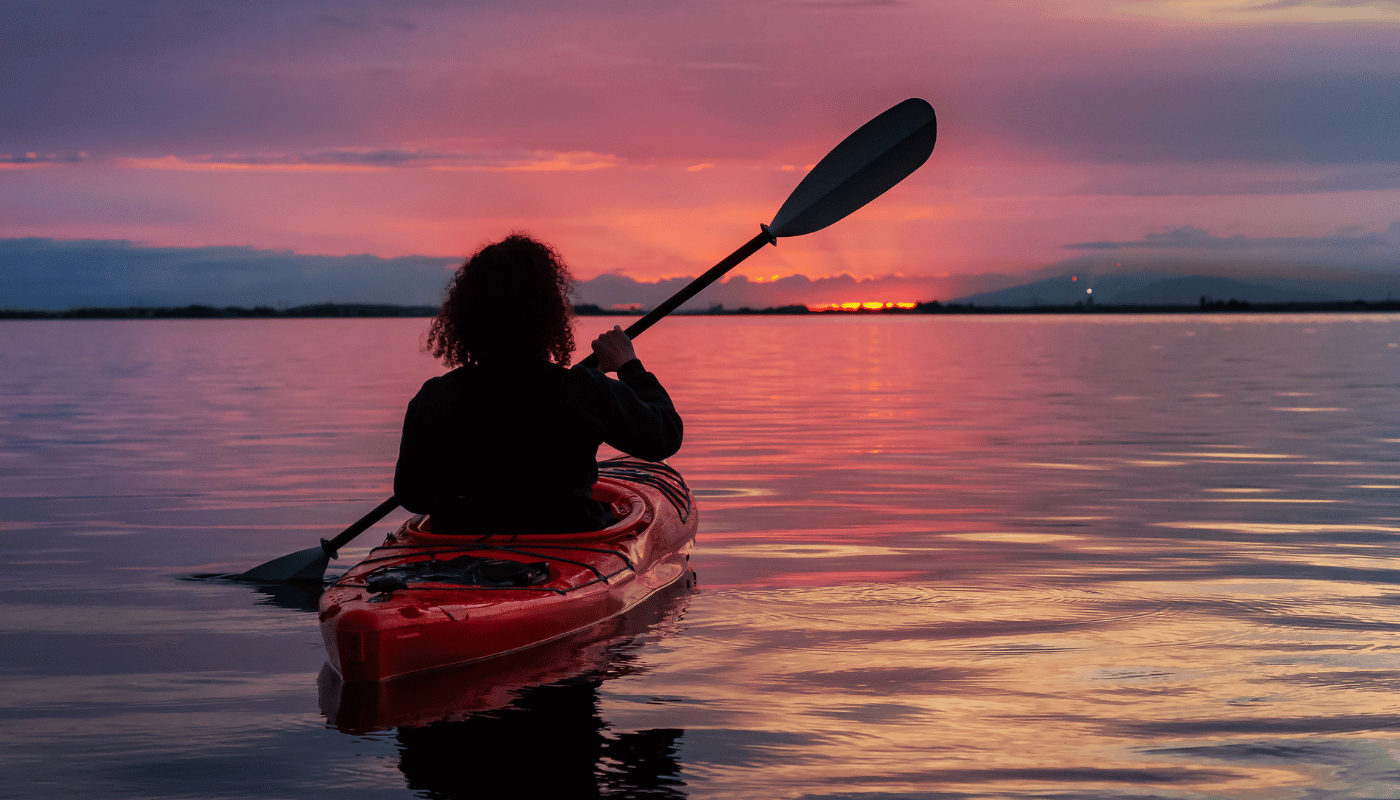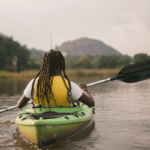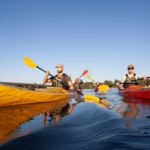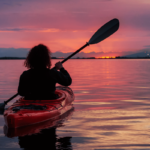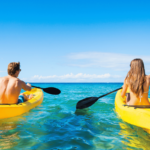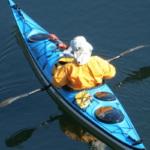Sea kayaking is an exciting outdoor activity that allows you to explore waterways and coastlines in a small, maneuverable boat known as a kayak. Unlike traditional kayaking, which is often done on lakes or rivers, sea kayaking specifically involves navigating open waters such as oceans, seas, and large lakes. This activity can be both relaxing and physically challenging, depending on the conditions of the water.
For many, what is sea kayaking is a question that sparks curiosity. It’s a unique way to connect with nature, providing kayakers with the opportunity to observe marine wildlife, explore coastal areas, or simply enjoy the serenity of being on the water. Whether you’re paddling through calm seas or navigating more challenging coastal waters, sea kayaking offers a dynamic experience that can be tailored to a range of skill levels.
What makes sea kayaking particularly attractive to adventurers is its accessibility. The sport doesn’t require expensive equipment or a lengthy learning curve, making it an appealing choice for beginners as well as seasoned paddlers. However, mastering the techniques and understanding safety precautions are key to ensuring a safe and enjoyable experience.
While the activity can be simple, it also offers room for progression, from leisurely paddling in sheltered bays to long-distance journeys across open waters. Whether you’re a beginner just starting to paddle or a more experienced kayaker seeking new challenges, becomes a journey of both skill development and adventure.
The Basics of Sea Kayaking
Sea kayaking is a thrilling water sport that allows individuals to explore vast bodies of water, such as oceans and large lakes, from the safety of a kayak. It’s important to know the basic components that make up the sport, starting with the essential equipment needed. Before you hit the road, it’s important to know what to wear for kayaking. Read here to explore essential tips and ensure you’re well-prepared for your adventure. Unlike traditional kayaking, sea kayaking requires specific gear designed to handle the challenges of open water, such as waves and currents. Sea kayakers often venture into more unpredictable environments, requiring a higher level of stability and endurance.
While the equipment is fundamental, mastering the skills to navigate the open water is equally important. Learning how to properly paddle, steer, and balance your kayak is essential to ensure a safe and enjoyable experience. Sea kayaks are generally longer and more narrow than river kayaks, which helps them handle the challenges of the sea. The double-bladed paddle, which is a hallmark of kayaking, helps in navigating longer distances and through various water conditions, such as waves, wind, and tides.
Essential Equipment for Sea Kayaking
- Sea Kayak: Designed for open water, with a long, narrow hull for stability and speed.
- Double-Bladed Paddle: Provides efficient paddling and maneuverability.
- Personal Flotation Device (PFD): Ensures safety in case of capsizing.
- Spray Skirt: Prevents water from entering the kayak, especially in choppy conditions.
- Appropriate Clothing: Wetsuits or drysuits to keep warm in cold water.
In addition to the equipment, understanding how sea kayaking differs from other types of kayaking is crucial. Unlike calm rivers or lakes, sea kayaking requires paddlers to deal with varying water conditions, including tides, waves, and wind. Being prepared for these elements is part of what makes sea kayaking an exciting and rewarding activity. Paddlers can start with short trips in calmer areas before progressing to more challenging conditions. Properly choosing your kayak and paddle can make a significant difference in how comfortable and efficient your experience is on the water.
Benefits of Sea Kayaking
Sea kayaking is not just an adventurous outdoor activity; it also provides a wide range of physical, mental, and environmental benefits. Understanding what is sea kayaking is one thing, but truly appreciating it comes with knowing how it can positively impact your health and well-being. Whether you are an experienced paddler or a beginner, sea kayaking offers an opportunity to enjoy the great outdoors while engaging in a full-body workout.
One of the primary physical benefits of sea kayaking is the improvement in cardiovascular health. Paddling works the upper body, particularly the arms, shoulders, and back, providing an excellent workout for your muscles. The constant motion of paddling also engages the core, helping to tone and strengthen the abdominal muscles. This makes sea kayaking a great way to enhance overall fitness, burn calories, and improve endurance. Over time, regular kayaking can also help improve balance, coordination, and flexibility, which can benefit other athletic activities as well.
Mentally, sea kayaking is a great way to reduce stress and improve mental clarity. Spending time in nature, especially on the water, has been shown to reduce anxiety, depression, and other mental health issues. The rhythm of paddling combined with the natural surroundings creates a meditative experience, allowing kayakers to clear their minds and focus solely on the present moment. The tranquility of the water, paired with the challenge of paddling, offers a unique way to relax and reset mentally.
In addition to physical and mental benefits, sea kayaking also allows individuals to connect with nature in a meaningful way. Whether you are paddling in calm waters or navigating through waves, the experience often involves observing marine wildlife, such as dolphins, seals, and various species of birds. This closer connection to the natural world fosters a sense of environmental stewardship, encouraging kayakers to protect the waters they explore.
Ultimately, sea kayaking provides a holistic experience that engages both the body and the mind. The combination of fitness, relaxation, and connection to nature makes it an activity that people of all ages and skill levels can enjoy, making it a valuable addition to any outdoor adventure routine.
Safety Precautions in Sea Kayaking
Safety is a critical aspect of any water-based activity, and sea kayaking is no exception. While sea kayaking is an exciting adventure, it can also be risky if the necessary precautions aren’t taken. Goes hand-in-hand with understanding the safety measures required to ensure a safe and enjoyable experience. Whether you’re a beginner or an experienced kayaker, there are essential safety guidelines that must be followed.
The first and most important safety measure is wearing a personal flotation device (PFD). A life jacket is a crucial piece of equipment that can save lives in the event of capsizing or emergencies. Make sure that your PFD is properly fitted and easily accessible at all times. Additionally, it’s important to dress appropriately for the water temperature, using wetsuits or drysuits when necessary to prevent hypothermia in colder conditions.
Before heading out on the water, check the weather forecast and be aware of the tides and wind conditions. Sea kayaking in calm weather is much easier and safer than paddling in windy or stormy conditions. Understanding the potential hazards in your area—such as strong currents, underwater rocks, or wildlife—can help you avoid dangerous situations.
Key Safety Precautions for Sea Kayaking
| Safety Measure | Description | Importance |
| Personal Flotation Device (PFD) | A life jacket worn to keep the kayaker afloat in emergencies. | Critical for ensuring the safety of the paddler. |
| Weather and Tide Check | Checking weather conditions and tide charts before heading out. | Prevents kayaking in unsafe weather conditions. |
| Appropriate Clothing | Wearing a wetsuit or drysuit in cold weather to prevent hypothermia. | Helps maintain body warmth in cooler waters. |
| Emergency Kit | Carrying a whistle, signal mirror, or other emergency gear. | Essential for signaling in case of emergencies |
The table above summarizes the key safety precautions necessary for sea kayaking. Following these measures will significantly reduce the risks involved. It’s also a good idea to let someone know your planned route and expected return time. If you’re kayaking in remote areas or for long distances, consider bringing a waterproof communication device for emergencies.
Advanced Techniques in Sea Kayaking
For those who have mastered the basics and are looking to take their sea kayaking skills to the next level, understanding advanced techniques is crucial. As you gain more experience, you’ll discover that what is sea kayaking extends far beyond simply paddling from one point to another. With the right techniques, you can navigate more challenging waters and improve your efficiency on the water.
One advanced technique is learning how to handle rough seas. This involves understanding how to read the water and how to adjust your paddling technique to stay in control during strong waves and currents. You can use specific strokes like the “brace” to help stabilize your kayak and prevent capsizing. Another important skill is the roll, a technique used to right your kayak if you capsize. Learning how to perform a proper Eskimo roll will significantly improve your confidence in the water and allow you to handle unexpected situations.
Another advanced technique is navigation and route planning. When kayaking in unfamiliar waters or going on multi-day trips, knowing how to use a map and compass—or a GPS device—can help you stay on course. Understanding tides and currents, as well as how to read the weather, will also help you avoid getting stuck or caught in dangerous conditions.
Common Mistakes to Avoid in Sea Kayaking
Sea kayaking is an exciting and accessible way to explore the water, but it’s easy to make mistakes, especially for beginners. Understanding what is sea kayaking is one thing, but knowing how to avoid common errors can make your kayaking experience much more enjoyable and safer. Some mistakes are simple oversights, while others can lead to dangerous situations. By recognizing these common pitfalls, you can ensure that you’re well-prepared for your next kayaking adventure.
One of the most frequent mistakes is not wearing the proper safety gear, particularly a personal flotation device (PFD). While it may seem obvious, it’s easy to forget, especially when paddling in calmer waters. But sea kayaking often involves unpredictable weather and rougher conditions, so wearing a PFD is always crucial. Additionally, not having a well-fitted kayak or a paddle suited to your size can lead to discomfort and ineffective paddling.
Another common mistake is neglecting to plan for changing weather conditions. The sea can quickly go from calm to choppy, and having the right knowledge about the tides, wind, and potential storms is essential for safety. Failing to check the weather forecast or to understand how tides and currents can impact your route is a mistake that can put your safety at risk. Additionally, overestimating your own paddling abilities and pushing yourself too far or too fast without proper training can lead to exhaustion or accidents.
Common Mistakes to Avoid in Sea Kayaking
- Not wearing a PFD: Always wear a personal flotation device, even in calm conditions.
- Neglecting weather checks: Ensure you’re aware of the forecast, tides, and currents before heading out.
- Using poorly fitting gear: Choose a kayak and paddle suited to your body size and skill level.
- Paddling too far or too fast: Know your limits and avoid overexertion.
Avoiding these common mistakes not only improves your kayaking experience but also keeps you safe on the water. The key is preparation, being aware of your environment, and knowing your own limitations. Before each trip, double-check your gear, plan your route, and keep safety a priority. This proactive approach helps prevent accidents, minimizes discomfort, and ensures you’re ready to face any challenges the sea might throw your way. Whether you’re a beginner or an experienced kayaker, avoiding these simple mistakes can make all the difference in enjoying the sport to its fullest.
End
In conclusion, sea kayaking is an exciting and accessible water sport that offers a variety of physical, mental, and environmental benefits. Understanding what is sea kayaking is essential for anyone looking to start this activity, as it provides a deep sense of adventure and an opportunity to explore the natural world from a unique perspective. Whether you’re paddling through calm bays or challenging ocean currents, sea kayaking offers an unparalleled way to experience the beauty of our waters.
The sport can be enjoyed by people of all skill levels, from beginners to seasoned kayakers, thanks to the variety of conditions and environments available. As long as proper preparation, safety measures, and an understanding of the sport’s basics are in place, sea kayaking can be both a safe and rewarding activity. By taking the time to understand the essential gear, techniques, and safety precautions, kayakers can ensure that their experience on the water is both enjoyable and enriching.
It’s important to remember that the journey is just as rewarding as the destination. With each paddle stroke, you are not only engaging in a full-body workout but also immersing yourself in the natural beauty of the world. By continuing to hone your skills and stay informed about safety and best practices, you can ensure that your sea kayaking adventures will remain safe, exciting, and full of memorable moments.
